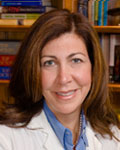
M. Michele Blackwood, MD, FACS, Breast Surgeon and Director of Breast Health and Disease Management at RWJBarnabas Health and member of the premier medical staff of Barnabas Health Medical Group (BHMG), a multispecialty practice affiliated with RWJBarnabas Health
Breast cancer is the most commonly diagnosed cancer among American women. Advancements made in genomic testing now allow us to pinpoint specific cancer types, for effective—but not excessive— and quicker treatment.
Mammography is almost always the initial imaging study used for the detection of breast cancer. It offers a potentially lifesaving benefit and it’s relatively easy, but the worst part of a mammogram can be waiting to get the results. Now that wait is dramatically shorter. The Breast Center at Saint Barnabas Ambulatory Care Center has implemented a faster way to get mammogram results to patients. As soon as the radiologist reads the mammogram and generates the report, a special software sends the report via email to the patient. Many patients can now receive their results the same day. Many women are frightened by what they may learn from a mammogram. They may have a personal history of breast cancer or family members who have had it, so it is helpful to end the suspense as quickly as possible. Beyond just getting results, our team of dedicated experts and specialists at Saint Barnabas Medical Center are able to see patients within 24-36 hours following a diagnosis which can be critical for advanced cases.
When a woman calls to schedule her yearly mammogram, she has the option to have any additional imaging done on the same day as her screening mammogram. Studies show that 1 in 10 women who have a screening mammogram need a follow-up exam. This helps to alleviate patient anxiety and expedite the process. In many cases, a biopsy, if needed, can be performed in the same day as well.
Over the past several years, the breast surgical oncology field has also made exponential advances that allow surgeons to personalize treatments. This significantly enhances the quality of care. We take the cosmetics of breast cancer very seriously because the emotional and physical results of breast cancer can be extreme. Fortunately, the advancements in surgery have helped to eradicate the cancer while also ensuring that women are not left disfigured and that they can return to their natural appearance. Some of the major advances in the field of breast reconstruction, include nipple-sparing procedures that allow patients to fully recover with their body image intact and new techniques that have significantly reduced the amount of scarring and disfigurement.
The two surgical choices you have when you have breast cancer are a lumpectomy vs a mastectomy. A lumpectomy is performed if:
- the tumor is removed with some surrounding tissue
- it is relatively quick
- it is usually an outpatient operation
If a mastectomy is performed:
- The gland is removed while leaving the skin (often breast reconstruction can be done in the same operation)
- It is done at the hospital and you could stay 1-3 days, depending on the patient’s health
When we talk to patients about whether to do a lumpectomy or mastectomy, we have very in-depth conversations. The type of surgery depends on:
- the size and location of the breast lump or tumor
- the type of breast cancer
- if the cancer has spread outside of the breast to the lymph nodes or other parts of the body
- the size of the breast
- the woman’s preference
- the biological type of breast cancer
Each patient and case is very different. We take all of the information we have and help to make the right decision. We tailor her breast cancer treatment for her life. In some cases, if a woman desires to keep her breast, but has a large tumor and relatively small breasts, we can give her chemotherapy first to shrink the tumor. Then we can do a lumpectomy instead and she keeps her breast.
Every patients’ diagnosis is unique and therefore requires an individual approach to treatment. At Saint Barnabas Medical Center, we examine the whole patient, including her family history and lifestyle in order to provide an accurate diagnosis and appropriate treatment. Age, genetics, risk factors and pathology exams must all be taken into consideration when we determine a game plan for the best treatment.
Visit Barnabas Health Ambulatory Care Center and find more information about breast care, how to prepare for a mammography, as well as surgery options and advances.
For more information visit www.rwjbh.org/mammo